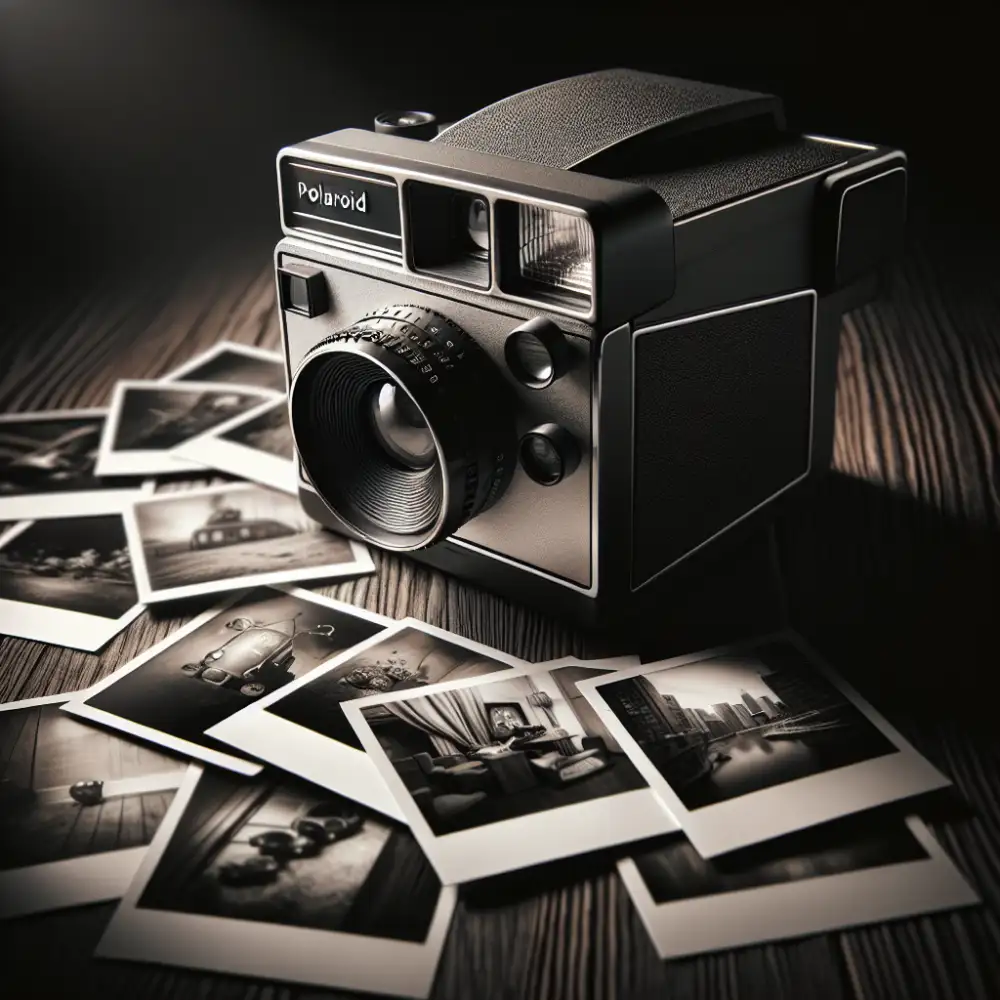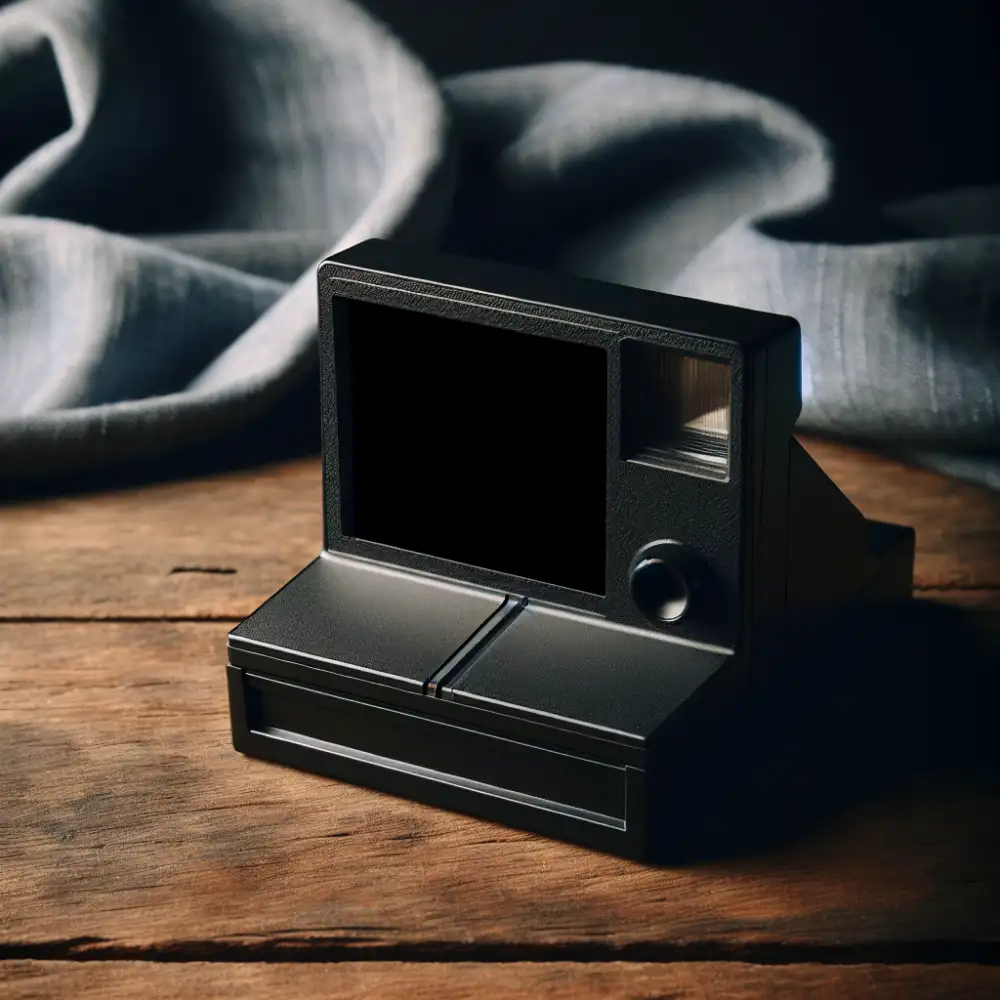Black Polaroid Film: The Comeback Kid of Instant Photography

Black and white film chemistry
Black and white Polaroid film, like its color counterparts, relies on a fascinating chemical process to develop images instantly. However, instead of dealing with multiple dye layers and complex color chemistry, black and white Polaroid film focuses on a more straightforward, yet equally ingenious, method.
At the heart of this process lies silver halide crystals embedded in the film's emulsion. These crystals are incredibly sensitive to light. When you snap a picture with your Polaroid camera, the shutter briefly exposes the film to light, forming what's known as a "latent image." This image is invisible to the naked eye, but it holds the blueprint for your final photograph.
As the film exits the camera, it passes through a pair of rollers. These rollers spread a thin layer of developing reagent, containing a chemical cocktail that sets the magic in motion. This reagent interacts with the silver halide crystals that were exposed to light during the picture-taking process.
Here's where the chemistry gets really interesting. The developer converts the exposed silver halide crystals into metallic silver, which appears black. The unexposed crystals remain largely unaffected. This difference in silver concentration creates the light and dark areas that form your black and white image.
A key ingredient in this process is a compound called hydroquinone. Hydroquinone acts as a developing agent, facilitating the conversion of silver halide to metallic silver. Another crucial component is sodium sulfite, which acts as a preservative, preventing the developer from oxidizing too quickly and ensuring consistent results.
To prevent further development and "fix" the image, a layer containing a fixing agent, often sodium thiosulfate, is also present. This chemical dissolves any remaining unexposed silver halide crystals, preventing them from reacting to light and darkening the image over time.
The result of this intricate chemical dance is a tangible, one-of-a-kind black and white Polaroid print that develops right before your eyes. The magic of this process, combining light, chemistry, and instant gratification, continues to captivate photographers and enthusiasts alike.
| Feature | Black & White Polaroid Film | Color Polaroid Film |
|---|---|---|
| Developing Time | 10-15 minutes | 15-30 minutes |
| ISO | Typically around 640 | Typically around 640 |
Development process differences
The development processes for black and white Polaroid film and the integral film used in most Polaroid cameras differ significantly. This is because they are fundamentally different film types.

Black and white Polaroid film, like traditional black and white film, uses a silver halide-based emulsion. When you take a picture, light strikes the emulsion, forming a latent image. The film then undergoes a chemical development process. This process involves a developer solution that converts the exposed silver halide crystals into metallic silver, creating the dark areas of the image. A fixer solution then dissolves the unexposed silver halide crystals, making the image stable and preventing further light sensitivity.
Integral film, the more common type of Polaroid film, is a more complex system. It contains multiple layers, including a negative layer, a positive layer, and chemical pods containing developer and other reagents. When a photo is taken, the negative layer is exposed to light. As the photo is ejected from the camera, it passes through rollers that rupture the chemical pods. This spreads the developer paste between the negative and positive layers. The developer initiates a chemical transfer process where the unexposed silver halide crystals in the negative layer are converted into a positive image on the positive layer. This process happens rapidly, allowing for "instant" development.
The key difference lies in the image formation and development location. Black and white Polaroid film develops the image directly on the exposed negative, much like traditional film. Integral film uses a transfer process to create a positive image on a separate receiving layer. This difference in technology results in the unique characteristics of each film type. Black and white Polaroid film offers a classic, grainy aesthetic, while integral film provides the instant gratification and vibrant colors that Polaroid is known for.
Unique aesthetic qualities
Black and white Polaroid film possesses a unique aesthetic charm distinct from other photographic mediums. The chemical process produces deep, rich blacks and bright whites, resulting in a high-contrast look with a certain drama. This stark contrast enhances textures, making subjects appear almost tactile. The absence of color further emphasizes form and shape, drawing the viewer's eye to the interplay of light and shadow.
Beyond the tonal qualities, black and white Polaroid film is known for its distinctive soft focus. Unlike the sharp precision of some films, Polaroids have a slight inherent blur that lends an ethereal, dreamlike quality to images. This softness can imbue portraits with a timeless, romantic feel, and landscapes take on an almost painterly atmosphere.
The unique development process of Polaroid film also contributes to its aesthetic. As the image slowly materializes on the surface, subtle variations and imperfections can occur, resulting in happy accidents that add to the charm. These might manifest as light leaks, emulsion drips, or uneven borders, each adding a touch of the organic and unpredictable to the final print.

This unpredictable nature is part of what makes black and white Polaroid film so appealing. It's a medium that embraces imperfection and spontaneity, producing images that feel both nostalgic and of the moment. It's a look that is difficult to replicate, imbued with a certain magic that continues to captivate photographers and viewers alike.
Popular black and white films
Black and white film has experienced a resurgence in popularity in recent years, particularly among instant photography enthusiasts. Polaroid cameras, known for their ability to produce physical prints instantly, have become synonymous with this nostalgic format. While Polaroid offers a range of color films, their black and white options hold a special appeal for photographers seeking a timeless and classic aesthetic.
One of the most popular black and white films for Polaroid cameras is the Polaroid 600 Black & White Film. This film is compatible with vintage Polaroid 600 cameras as well as newer i-Type cameras. It is characterized by its high contrast, sharp details, and classic black and white tones. Photographers appreciate its ability to capture a wide range of subjects, from portraits to landscapes, with a timeless feel.
Another beloved option is the Polaroid Originals SX-70 Black & White Film. Designed for use with vintage Polaroid SX-70 cameras, this film delivers rich blacks, bright whites, and a smooth tonal range. Its unique square format adds to its vintage appeal, making it a favorite among photographers who appreciate a touch of nostalgia in their work.
For those seeking a more experimental option, the Polaroid Originals B&W Duochrome Film offers a unique twist on traditional black and white photography. This film features a two-tone color palette, typically black and another color such as red, blue, or yellow. The result is a series of surreal and eye-catching images that push the boundaries of black and white photography.
Whether you are a seasoned photographer or just starting out, black and white Polaroid film offers a unique and rewarding way to capture the world around you. Its timeless aesthetic, instant gratification, and ability to evoke a sense of nostalgia make it a compelling choice for photographers of all levels.
Tips for shooting in black and white
Black and white Polaroid film offers a unique and timeless aesthetic. Here are some tips to help you capture stunning black and white Polaroid photos:
Understand light and shadow. Black and white photography relies heavily on contrast to create depth and interest. Pay attention to how light and shadow fall on your subject and use them to your advantage. Look for scenes with strong contrast or create your own by using artificial light sources.
Focus on texture and form. Without color to distract the eye, texture and form become more prominent in black and white photographs. Look for subjects with interesting textures, patterns, and shapes.

Experiment with different lighting conditions. Overcast days can produce beautiful soft light that is perfect for portraits or still life. Bright sunlight can create dramatic shadows and high contrast.
Keep your compositions simple. With black and white photography, it's often best to keep your compositions simple and focus on a single subject. This will help to draw the viewer's eye to the most important elements of the image.
Don't be afraid to experiment. The beauty of Polaroid is its instant nature. Don't be afraid to experiment with different compositions, angles, and exposures. You never know what you might create.
Embrace the imperfections. Polaroid photos are known for their unique imperfections, such as light leaks and vignettes. These imperfections can add to the character and charm of your images.
Choose the right film. Different black and white Polaroid films have different characteristics. Some films are sharper, while others have more grain. Experiment with different films to find one that suits your style.
Store your film properly. Polaroid film is sensitive to heat and light. Store it in a cool, dry place until you are ready to use it.
With practice and experimentation, you can master the art of black and white Polaroid photography and capture stunning images that will last a lifetime.
Published: 23. 06. 2024
Category: Technology



